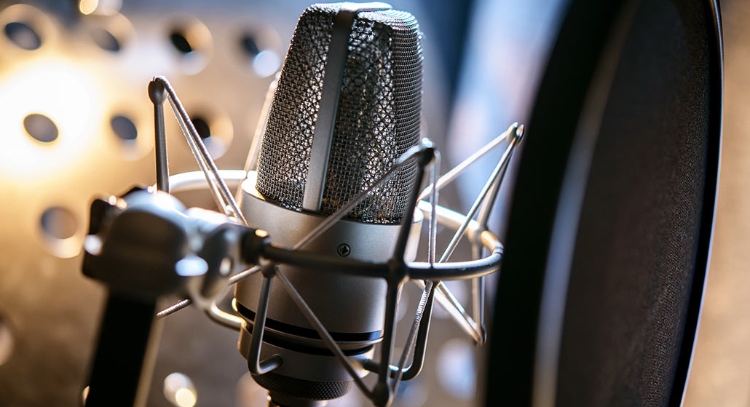A crucial step in setting yourself up for success as a voice actor is ensuring that you choose the right microphone for your voice.
Once you’ve settled on the best microphone for your voice (and for your wallet) you want to make sure that you care for and preserve your microphone so that you can get the most out of your investment.
In this article
- Tip #1: Consider a Pop Filter
- Tip #2: Keep Distance Between Your Mouth and the Mic
- Tip #3: Turn off Microphone Properly
- Tip #4: Store Microphone Safely
- Tip #5: Be Aware of Where You Set Down Your Microphone
- Should I Clean My Microphone?
- How to Take Care of Your Mic — Takeaway Tips
Put Your Voice Over Skills to Work
Create a free profile and start getting invited to jobs. Over 5,000 jobs posted monthly.
So what are the proper ways to take care of your microphone and ensure that you keep it in pristine condition over the long-term, whether or not it’s an expensive mic?
Here are 5 tips for preserving and caring for condenser mics:
Tip #1: Consider a Pop Filter
In the industry there is a debate on whether or not pop screens are needed for condenser mics and if they are even useful. Well, one great thing about a pop filter is that it will intercept any saliva that may be headed towards the mic during recording and will keep the charged mic diaphragm and electrically charged capsule clean.
Over time, a contaminated capsule will eventually have a negative impact on the high frequencies that are emitted and cause unwanted feedback and discharge noise.
Tip #2: Keep Distance Between Your Mouth and the Mic
A general rule of thumb when recording vocals is to keep your mouth about 6 inches away from your microphone during a recording session. This will prevent plosives from damaging the capsule.
If you are too close to the mic and accidentally pop your “p’s” too hard, the continuous popping sounds will eventually wear down the capsule of your microphone.
Tip #3: Turn off Microphone Properly
Make sure that you connect the cable from the power supply to the tube condenser mic before turning the supply on. Shocks from a live power supply can damage the tube of the mic.
Tip #4: Store Microphone Safely
It’s a great idea to store your condenser microphone in a plastic bag when you are not using it. A plastic bag will stop dust and particles from settling on the capsule. This can then be placed in a mic locker or other storage space.
Put your mic in a plastic bag when you are not working and make sure to bag the mic before storing it back inside the case.
What if your microphone is set up on a tripod boom or other mic stand in a way that it’s not possible or convenient to store it back in its case between studio uses? Just cover your mic with a plastic bag wherever it lives permanently.
Tip #5: Be Aware of Where You Set Down Your Microphone
Condenser mics are very sensitive instruments that respond to very minimal pressure changes. Think of it this way – you should not put your condenser mic anywhere you would not put your ears (e.g. near speakers is a definite ‘no’).
Also be sure to store your microphone in a place that is not damp and at room temperature. Avoid cold or hot rooms.
Should I Clean My Microphone?
It is very important to avoid water or any liquids when taking care of your condenser microphones. Even a small amount of moisture may damage a condenser element. The short answer is cleaning the diaphragm of a condenser microphone is very tricky and you don’t want to do any damage.
You can hire a professional to clean your mic, or simply add a pop screen or filter anytime you are using your microphone. This way, you can prevent any buildup of saliva particles and avoid worrying about cleaning your microphone too often — if at all.
Sending in condenser microphones for servicing can help detect potential damage early. Slight soiling can be removed much more easily than a layer of nicotine that has been embedded firmly in the diaphragm of the mic.
Regular check-ups of microphones on loan or those used in dusty or smoky environments can prove especially beneficial, as the cost is small compared to that of a major overhaul.
How to Take Care of Your Mic — Takeaway Tips
Keeping your mic in great shape takes proper care and consideration. Here are some takeaway microphone care tips:
Storage: Be sure to store your microphones away properly in storage cases to stop airborne dust from getting in or cover the mic in a plastic bag when not in use.
Pop Filters: To preserve audio quality, a pop filter will prevent saliva build-up on the diaphragm of a tube condenser mic.
Professional Care: Consider regular servicing of your condenser mic by a professional to ensure the longevity of your microphone and that the audio being captured is always of the highest quality audio. This also goes for a ribbon mic or any of the audio equipment in your mic locker.

Comments
Thank you for this solid refresher course in protecting your mic in a mic closet. We’re a humble studio with only 30+ mic’s to work with. I have a standard here, with my small staff of engineers – ‘Love the Mic’s, Glove the Mic’s’. Each microphone carries purpose & charm. So be it a $200 mic or a $5,000 mic, they all deserve the respect you can give them. Since our individual body chemistry is different, we need to remove this aspect in the formula in our approach. White glove protocol is our form of this respect.